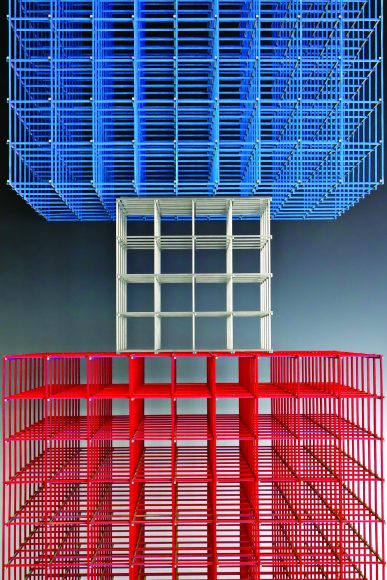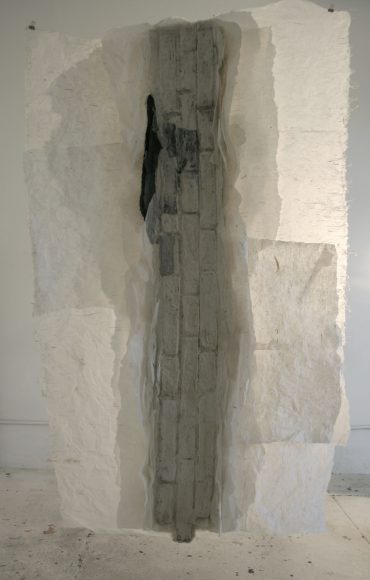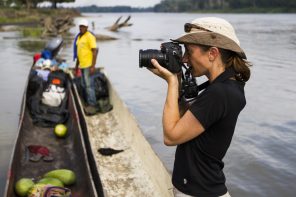At first glance, New York City and Beijing might not seem like the most natural pairing. Talk to Far East experts and they’ll tell you that New York City is more like Shanghai – a financial capital and great going-out town. Whereas Beijing pairs up nicely with Washington, D.C. as both are actual capitals.
“But New York and Beijing have the largest concentration of artists,” said Susan Ball, deputy director of the Bruce Museum in Greenwich. “Also, New York is the capital of the art market. … The New York sales are the most important.”
And so we have “Tales of Two Cities: New York & Beijing,” a provocative, richly textured show through Aug. 31 that’s about the dialogues and disorientation created by globalization.
It began when Cristin Tierney of the Tierney Gardarin gallery in Manhattan introduced Ball and her Bruce colleagues to exhibit curators Michelle Y. Loh and Pan Qing. They and advisers Sarah McNaughton and John Rajchman had an idea for an exhibit that would pair New York-based artists with Beijing-based ones. Qing had done this on a smaller scale when she put together a show of works in ink by Michelle Fornabai and Qin Feng at Columbia University’s Studio-X in Beijing during the summer of 2010.
They’re in the Bruce show as are Joan Snyder and Wei Jia, whose canvases are concerned with the dense layering of materials; Alois Kronschlaeger and Lin Yan, who’ve created site-specific installations for the Bruce; Jorge Tacla and Li Taihuan, whose paintings explore the effects of urbanization; and Simon Lee and Chen Shaoxiong, whose mixed media works consider the nature of time as they reinvent the cinematic.
These are not collaborative works but pairings of complementary, parallel pieces by artists who have connections to other places. Fornabai and Feng have studios in Boston as well as New York and Beijing respectively. Lee is from the United Kingdom. Tacla has studios in New York and Santiago, Chile.
The pairs communicated via email, telephone and Skype as well as in person, sometimes with translators. (Indeed, the exhibit would not have been possible without mass media and transportation.)
“It depended on the pairs,” McNaughton said at the press preview. “Some like Lin Yan and Alois (Kronschlaeger) went to each other’s studios.”
Their site-specific installations are the most dramatic examples of the pairs as complements. Kronschlaeger has contributed a skyscraper of red, white and blue cubes that play with light. It’s the yang to Yan’s yin – a chandelier of casually crumpled paper held together with push pins from which a fierce white bird emerges.
Sometimes the artists didn’t communicate at all, at least not verbally as a film of Fornabai and Feng working side-by-side demonstrates.
They illustrate the concept of moku – “the artist is ultimately revealed in ink.”
“I feel we understood each other,” Fornabai said, “and we never exchanged any words.”
Fornabai’s 2013 installation “Concrete Poetry: Digging to China (Holes),” which looks like a 3-D brush painting with mirrors suspended above it, plays with the expression that if you could dig a hole deep enough, you’ll come out in China. Fornabai is intrigued by the idea of being upended on the far side of the world. (Hence the mirrors.) The disorientation hinted at in this work, a theme throughout the exhibit, is a companion of urbanization and globalization. Tacla’s paintings “Rubble 10” (2007) and “Altered Remains 04” (2011) – which consist of adding then subtracting acrylic and oil paints and marble powder from canvases – depict disintegrating cities. They’re juxtaposed with Taihuan’s oils on canvas “Beijing 2013” and “Misty Beijing” (2013-14), in which the city is swathed in pastel, Impressionist pollution.
“This one is even more directly responding to the pollution in Beijing,” co-curator Loh said, referring to “Beijing 2013,” a work that consists of 12 square paintings. “One painting couldn’t convey the chaos he’s experienced.”
It’s not just pollution, urban life, travel and spontaneity that “blur the lines,” as Loh puts it, but the passage of time. Lee’s “Mother Is Passing. Come At Once.” (2013) uses lenticulars – images that convey the illusion of depth and movement, made in this case with snapshots collected from different times and places. A boy in a bathing suit becomes an old man. A boy and a priest become two dogs.
But as Lee told the press, the audience causes the transformation by walking by the panels from this series or viewing them from different angles.
The dialogue in “Tales of Two Cities,” then, is not just between pairs of artists, or an artist and his work but between the work and the viewer.
Says Bruce deputy director Ball, “You have your own dialogue with each individual piece.”
For more on the exhibit and programs, including “China Family Day” (June 15), visit to brucemuseum.org.






